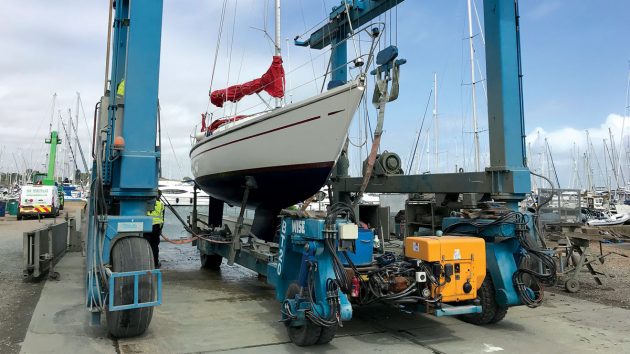PBO experts offer their top tips for winterising a boat, helping to keep your vessel and gear in good condition over the colder months
Winterising a boat: 61 point checklist
Checks while afloat
- Problems which are blindingly obvious afloat can be virtually impossible to locate ashore, so take the opportunity to mark any leaks and creaks ready for work ashore. Hull/deck joins, cleats, stanchions and other deck fittings are typical culprits.
- The same applies to the engine, especially the stern gear and engine mounts. It’s much easier to locate problems when the engine is running in the water.

Remember to leave fresh oil in the engine over winter. Credit: Graham Snook/YM
- If your boat will be lifted onto a trailer, take the chance to service the hitch, hubs, brakes and tyres without the boat in the way.
- If you can, service the engine now. This allows the engine and filters to be thoroughly coated with fresh oil and corrosion inhibitors, and distributes antifreeze through the cooling system. Change the oil when the engine is warm.

Inserting a rag in the exhaust outlet prevents creatures and moisture entering the pipe. Credit: Duncan Kent
- Stuff a rag into the air intake and exhaust pipe.
- A bucket over the propellers will protect heads and hands from the sharp edges of the blade.
- If you aren’t planning to take the rig down, send someone up the mast to check swages, sheaves and angles in the rigging wire, and to check the electrics, in case you find something that requires taking it down. The yard would rather take down the mast at the same time as lifting the boat than be asked later.

Send someone up the mast to check swages, sheaves, and angles in the rigging wire
- While up the mast, disconnect the mast top VHF aerial to avoid damage in a lightning strike.
- Read how to service a marine diesel engine in 12 simple steps
Checks before lift out
- Try to organise some time alongside with easy access to the car. It’s much easier to unload the boat when you’re not climbing up and down a ladder.
- Take off the sails. If you have access to a hose, you can quickly wash them off with fresh water, hoisting a few feet at a time. Make sure you sluice your furling gear too.
- Check and replace the water pump impeller if it shows sign of ageing. Don’t forget to install a new gasket on the pump faceplate.

If you’re not going sailing, remove the sails to prolong their life. Credit: Graham Snook/YM
- Remove the dodgers and spray hood to reduce windage for the lift. Remove any sheets that could get tangled, and tidy up your halyards.
- Empty your water tanks while afloat – it’s much more sociable than creating a flood in the boatyard. Make sure you drain the tanks, pipes and calorifier to prevent the water inside of them freezing if it gets too cold. Add lemon juice or Milton in your water tanks to keep them fresh.
- Take off gas bottles and petrol cans to minimise fire hazards. If you can’t take the gas bottle home, make sure it’s disconnected and it can’t leak.
- Some experts argue that it’s best to keep your diesel tanks topped up with a dose of diesel bug treatment to inhibit condensation and corrosion. Others argue against this, due to the contamination caused by diesel which has been left in the tank for a while.

Burn off any gas and disconnect the bottle. Credit: Graham Snook/YM
- Remove or retract your transducers and fit the blanking caps – transducers can be damaged by the crane’s lifting straps.
- Make sure the lifting points are clearly marked – this will help the yard hoist your boat quickly and on the level.
- Lash down or remove the boom, and any other loose objects that could get in the way as the boat is lifted.
- If you plan to drop the mast, disconnect all running rigging and electrical cables attaching it to the deck, and ease off the bottlescrews to make the yard’s job quicker.
- Even if the mast is staying up, some boats will need the backstay to be eased to clear the crane.
- Pump the bilges, then switch off the pump. The yard staff won’t thank you if your automatic pumps showers them with stagnant water as they lift the boat, and it will save your batteries.
On the hard
- Pressure wash below the boat’s waterline. Fouling sticks hard once dry, so this is a great opportunity to remove it. Most yards offer pressure-washing as part of the service, and it’s worth taking advantage of their powerful equipment.
- Wash your topsides and decks to shift the salt. It all helps to keep the boat dry.
- Remove the running rigging, replacing where appropriate with mouse lines. Take all your lines home and rise them in fresh water and a mild detergent.

Removing lines over winter and washing them will prevent mould. Credit: Duncan Kent
- Rinse out the salt from your blocks, furling gear, mainsheet traveller and genoa tracks with fresh water and check for wear.
- Remove any on-deck items such as the liferaft and Danbuoy which will deteriorate when left outdoors. Either take them home or store them inside the boat.
- Ensure the scuppers are clear to allow for easy drainage.
- Drain any water from the heads and holding tanks, and run some washing-up liquid through to keep them fresh and prevent freezing.

Make time to pump the heads through with fresh water. Credit: Graham Snook/YM
- Run the engine to pump fresh water through the raw water cooling circuit – use a bucket or a hosepipe. If you have a closed-circuit cooling system, check and top up the antifreeze. Boats with raw water-cooled engines should have the engine flushed through with a mix of fresh water and antifreeze.
- Disconnect the batteries and connect them to a solar panel or trickle-charger. If possible, take them home to keep them away from frost.
- Make sure lead-acid batteries are topped up to the correct level with de-ionised water.

Ensure the engine is topped up with enough antifreeze. Credit: Graham Snook/YM
- Check all the sheaves in the mast are running freely and are undamaged. If necessary, drive the shaft pin out and check – they often wear on the inside of the sheave. If they won’t turn at all, first try a kettle of hot water – it’s more effective and less messy than WD-40.
- Once sheaves are moving, use a dry silicone lubricant to keep them that way.
- Clean the inside of the boat with fresh water to remove salt deposits.

If you can, disconnect batteries and take then home. Credit: Graham Snook/YM
- For preference, remove all soft furnishings and take them home. If this isn’t possible, make sure you prop up the berth cushions so that air can reach both sides.
- Flush through your seacocks with fresh water to remove the salt. If you have traditional tapered seacocks, remove the barrels to prevent them seizing.
- Ensure the boat is well ventilated – it’s good to lift some of the boards in the cabin sole to let air reach the bilge. You could run a dehumidifier to keep the damp at bay.

Removing cushions and mattresses will stop moisture damaging them. Credit: Graham Snook/YM
- Covering the boat is a good way to keep your timber in good condition, and the boat is dry for working. If you have a wooden boat, a cover is a must.
- Do not tie the cover to any supporting legs, trestles, chocks or struts – if the cover flogs in a gale, it may dislodge the support with disastrous results.
- Ensure there is adequate ventilation.

Try not to let tarpaulins rest against the topsides, it can lead to a scuffed hull. Credit: Duncan Kent
- Check the boat carefully for leaks which might let the rain in. The idea is to ensure a dry boat, but encourage ventilation.
- Moving parts such as spinnaker pole pins should be lightly oiled or greased to prevent corrosion.
- Take easily removable objects such as the outboard and electronics home to prevent theft. Thieves have even been known to steal propellers.
- Check your stern gear and rudder bearings for play or visible wear.
- Take your anchor and chain out of the locker to prevent it from rusting up.

Remove from the boat any food that’s open or perishable. Credit: Graham Snook/YM
- Check props or cradle for security before leaving the boat. Make sure to lock the ladder to the cradle. A doormat at the ladder’s base will help keep decks clean.
- Remove all food from the boat to deter rats and mice and try and make it as hard as possible for pests to get on board the boat.
Staying afloat
- Try to secure a snug, sheltered berth. If you are on a pontoon, choose the leeward side from the prevailing wind.
- Deploy plenty of heavy-duty fenders. Some people even wrap old tyres in canvas, as conventional fenders can pop under pressure of a gale.
- Use a fender cloth on your topsides to minimise chafe.

Drain fresh water tanks and leave taps open. Credit: Graham Snook/YM
- Double up all your mooring lines, and protect them from chafe. Plastic hose through the fairleads is ideal.
- Clean the side of the boat to remove salt deposits and help drying.
- If possible, remove all the soft furnishing to avoid mould and mildew growth.

Ventilation in all forms is good for a sweet smelling boat. Credit: Duncan Kent
- Take off your sails and stow them below decks.
- Drain your fresh water tanks.
- Service your engine to renew corrosion inhibitors and antifreeze.

Prevent moisture damage by keeping the interior as dry as possible. Credit: Graham Snook/YM
- Make sure the boat is well ventilated. Open lockers and lift cabin sole hatches to help air circulate. You could also run a low-level heater to help keep the boat dry.
- Visit your boat at least once a month and on each visit, sponge out any accumulated water, Check first if it is fresh or salt water.

Keep lines off the deck to stop them festering. Credit: Duncan Kent
- Ensure any lines or poles which are left on the deck are lifted up to prevent them from collecting dirt or going green.
- Whether you are leaving your boat on the hard or in the water, ensure you have adequate insurance coverage for the winter months.
Enjoyed reading Winterising a boat: 61 point checklist? 
A subscription to Practical Boat Owner magazine costs around 40% less than the cover price.
Print and digital editions are available through Magazines Direct – where you can also find the latest deals.
PBO is packed with information to help you get the most from boat ownership – whether sail or power.
-
-
-
- Take your DIY skills to the next level with trusted advice on boat maintenance and repairs
- Impartial in-depth gear reviews
- Practical cruising tips for making the most of your time afloat
-
-





